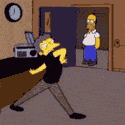|
Mradyfist posted:What are you planning on doing in this basement that doesn't care about acoustics? Sex dungeon.
|
|
|
|

|
| # ? May 21, 2024 00:04 |
|
Don't be stupid, of course you need good acoustics for a sex dungeon. Who wants a sex dungeon that's just flutter-echoing all the time? That'd be really annoying, at a minimum you could figure out some diffusion that would fit with the theme, like maybe a quadratic diffuser made out of dildos.
|
|
|
|
"How do I effectively block out the frequencies that children scream at"
|
|
|
|
nrr posted:"How do I effectively block out the frequencies that children scream at" This post plus that avatar is pretty amazing. I'm not sure as to the answer to your question, but I've noticed that a lot of background sounds that bug me listening to an individual track don't come through at all when I have everything playing together. I'm biased though, since I like kind of a lo-fi sound.
|
|
|
|
I'm looking for a quality desktop mic stand for use with a Sure Beta 57, Sennheiser e835, and Rode NT2-A. Any recommendations? I'd like to avoid OnStage if possible, as every OnStage product I've owned has been a poorly built piece of crap, but some stores don't seem to have any desktop stands that aren't OnStage.
|
|
|
|
The Atlas DS7 is probably what you want. Pretty much every tiny piece of an Atlas stand is replaceable, although you probably won't have to. They have as big and heavy of a base as you'll find for a desktop model, but if you want to extend your condenser more than a few inches from the stand you'll either have to weight the stand further or buy a $50 counter-weighted boom arm for it instead of a $25 regular boom arm.
|
|
|
|
Looks good to me. Thanks
|
|
|
|
I'll preface this by saying I have almost no idea what I'm doing. Here's what I have: M-Audio ProjectMix I/O JazzMutant Lemur Bugera 333XL Infinium playing into an Engl XXL 4x12 that I THINK I want to mic with my Shure SM57. What do I want to do? Record songs I've written. I'll be recording on a PC (ProjectMix -> FireWire card, right?), though I'm not sure if the ProjectMix or Lemur are compatible with Reaper. I want to figure out how to properly record my guitars first, then I wanted to insert percussion with Drumkit from Hell. After all that, and before I buy anything else, I wanted to know if the Audio-Technica AT2035 is a good mic for recording vocals. I'm going on the assumption that I can record that via the ProjectMix as well. I'm hoping I'm right, and if not my only saving grace is that I didn't spend anywhere near as much as it sounds for all the gear.
|
|
|
|
BobOfDoom posted:I'll preface this by saying I have almost no idea what I'm doing. Yes the ProjectMix will act as an interface and a mixer controller (so yes you can record through it). SM57 should be fine for the guitar, it's pretty standard. The AT2035 will be just fine for vocals, I have the AT3035 and really like it for what it cost. You'll need to use phantom power to use the AT2035, so make sure you switch that on on the project mix when it's time to record. The Lemur and the ProjectMix should work fine on Reaper once you get the inital setup out of the way. I've never used Reaper, but a brief Googleing seems to suggest that the PM should play nice.
|
|
|
|
I am having a problem trying to get a clean, crisp tone out of my mic and amplifier. Currently I am using this basic style of trial and error for my EQ: http://www.seymourduncan.com/tonefiend/recording/how-to-mic-an-amppart-1-the-basics/ My equipment is: Line 6 POD 2.0 (being run through) Line 6 Spider IV 30 set to maximum clean so the POD makes as much of the tone as possible cords are monster, those are fine, guitar is a Dean Vendetta, that's fine. Microphone being used: Shure 58 Using the technique showed in that article there, I have managed to confirm that I get a much cleaner sound in the middle, with a more intense sound as you get closer. This is the sound I would like to get close to Now, obviously since my equipment for recording is worth 600 dollars and not 6 thousand, I'm not going to get anywhere close to that noise. But is this sort of sound just not something that this Shure is capable of getting? TL;DR can I get Petrucci's presence out of this amp if I gently caress around for another 2 hours with settings or am I using the completely wrong kind of microphone period for that? I'm okay with not getting his tone, since the POD can only emulate so much, but my recordings have the guitar sound kind of distant, instead of really in your face like Glass Prison. I'm not even really sure what the word for that is to describe that sort of punchy tone that breaks through the mixing.
|
|
|
|
NTT posted:I am having a problem trying to get a clean, crisp tone out of my mic and amplifier. I don't want to come of as a dick, but can you make your guitar sound like that in the first place? I only say this because for a long time I didn't really pay a whole lot of attention to the sound coming out of the amp and just thought I could fix it all later. But in the end poo poo in=poo poo out. Get the tone you want first then try to mic it up. As an aside running a pod into the input of amp is really not optimal, if you have a power amp in use that so you're not getting boosted by 2 preamps. Also a 58 is not optimal for guitar either but I would think you should get something usable with it.
|
|
|
|
I'm not really having problems with the tone; I can record sound that is fairly clear as well. My issue is that I can't get it to record something that doesn't hog up the EQ; namely, when I try to layer different things, the live recordings overpower the synth stuff really easily, and I'm really not sure whether that's a hardware problem or just something I haven't learned with software yet. The question I guess I'm trying to pose is: should my sound be clear like that recorded raw, or is that sort of clean, easily discernible sound amongst the mix more of a post-production process?
|
|
|
|
Sorry if this has come up before - I did do a search but couldn't see anything - but does anyone have experience of recording on cassette tapes? I play acoustic, folksy type stuff, and made an album earlier this year that I recorded on an old digital dictaphone. It gave me the lo-fi sound I was looking for and was very reminiscent of the hiss found on tapes. That dictaphone died recently and I'd like to try out actual tapes, just for fun, really. I've no problems getting the audio off and stored digitally. I'm just wondering if anyone could recommend a reasonably priced, simple recorder, that's going to give that stereotypical 'warm' feeling to my songs. I terms of price I'd be looking at something like £50, or $70-80. Any help will be much appreciated!
|
|
|
|
Benzoyl Peroxide posted:Sorry if this has come up before - I did do a search but couldn't see anything - but does anyone have experience of recording on cassette tapes? Are you looking for multitrack? Tascam made a line of two and four-track recorders that were pretty decent. You can find them used on eBay or posting on Craigs List. The four-track Tascam portastudio was the cornerstone of the indie/low fi movement in the 90s. The nice thing about them was that they offered speed options to improve or degrade the taping quality, a little Eq and the ability to bounce tracks.
|
|
|
|
If you want lo-fi you can probably find a tape recorder lying around somewhere for free, that'll give you a lot of the style and warble and compression that makes a tape sound like a tape. It depends how lo-fi you want to go really
|
|
|
|
I have been playing around with a side project and recording it all through Reaper using an M-Audio AVID Recording Studio. The guitars are going through Amplitube 3 using Impulses as the cab simulation and mixed using EZMix 2. Bass is about the same but using the Ampeg SVX VST and also an Impulse for the cab simulation. Drums are Addictive Drums. Most of the channels are being mixed by EzMix2, but I'd love some feedback on how it's all sounding (even if its just a few demo tracks with no vocals!).  
|
|
|
|
NC Wyeth Death Cult posted:Are you looking for multitrack? Tascam made a line of two and four-track recorders that were pretty decent. You can find them used on eBay or posting on Craigs List. The four-track Tascam portastudio was the cornerstone of the indie/low fi movement in the 90s. The nice thing about them was that they offered speed options to improve or degrade the taping quality, a little Eq and the ability to bounce tracks. Thanks for the reply. I'm not too bothered about multi track ability, though it is a temptation. It pushes the price up an awful lot because of all the extras you mention... I likely wouldn't use them that often is all. It's something to think about! Cheers.
|
|
|
|
You should be able to snag a Tascam Portastudio 414 or 424 for under $50-ish no problem on ebay.
|
|
|
|
I just bought a Roland Juno 60 and want to record it into ableton. I need a audio/midi interface that has a really clean line in, with additional midi in out capabilities. My current system is retina macbook pro -> ableton, with apc 40 and novation x station as midi controllers. My friend suggested a Focusrite 18i6 - anybody see any problems/ have any experience with this? I previously had a m-audio fast track usb from like, 2005 and it didn't have good sound quality at all. Dream setup would be a prophet 08 and juno feeding directly into ableton with minimal input lag, and the ability to play the synths through ableton with VSTs/effects real time, and just using the ableton master as the primary audio out. Thoughts? Chim fucked around with this message at 17:24 on Aug 28, 2012 |
|
|
|
Chim posted:I just bought a Roland Juno 60 and want to record it into ableton. I need a audio/midi interface that has a really clean line in, with additional midi in out capabilities. That Focusrite should do the trick, though if you want a really great sounding interface the Apogee Duet is gorgeous sounding, though it lacks midi in/out afaik.
|
|
|
|
I just finished reading Mixerman's "Zen and the Art of Mixing" and thoroughly enjoyed it. It's less of a detailed technical guide / recipe book (there are plenty of other books for that) and more about philosophy, attitude, and cultivating a perspective to help you get the most out of your mixes. Mixerman's writing style is a nice balance between opinionated and down-to-earth; he can be entertainingly cocky, but his attitude is friendly and open to new ideas. That's not to say there's not some solid concrete advice too. Some of the specifics that have got me thinking: - I'd always followed the advice to never compress the master buss until the very end of a mix. Mixerman advises the opposite, that one of the first things you should do is put a compressor on the main outputs. Reason being the buss compressor is part of the character of the mix, and you should establish that from the beginning, rather than adding it as an afterthought. (Of course, in this context, "buss compressor" does not mean "track slamming brick wall limiter"). - He talks a lot about how the purpose of the mix is to bring out the best in the song, to give the listener a pleasing and emotionally evocative experience. If you have a choice between doing those things and making a mix that sounds technically perfect / accurate, it's better to sacrifice a bit of fidelity and "perfection" to make something that's interesting and memorable. - As an example of the above, he advises against stereo mic-ing acoustic guitars (assuming there is a vocal in the song). Stereo mic'd acoustic guitars sound big and bold and vibrant, but if there's a vocal you don't want to upstage it. Just because you can make a part sound rich and pretty doesn't mean that's what's best for the song. - Mixerman is a big proponent of LCR (hard panned) mixing, which I am finding a refreshing approach -- it's an easy way to create space in a mix, it makes a lot of decisions easier, and again, it's about making the mix work as a whole, not bringing out every nuance of every instrument simultaneously at all times. - There is a fair amount of discussion of the inherit limits of digital summing, and how an analog summing box is a dramatic improvement to any serious ITB/DAW setup. Does anybody here want to weigh in on this one? I've been around analog gear enough to know that there's an ease and clarity and "it sounds good" je ne sais quoi-ness to it, but I've never thought about it specifically in terms of summing.
|
|
|
|
h_double posted:- I'd always followed the advice to never compress the master buss until the very end of a mix. Mixerman advises the opposite, that one of the first things you should do is put a compressor on the main outputs. Reason being the buss compressor is part of the character of the mix, and you should establish that from the beginning, rather than adding it as an afterthought. (Of course, in this context, "buss compressor" does not mean "track slamming brick wall limiter"). If I'm working on tracks that will be going to a mastering engineer later, I usually like to toss on a decent buss compressor and limiter on the master, keep it fairly gentle, and do all my mixing with it on. Then when I'm finished, I bypass it for the renders that are going to mastering (and obviously bring my levels down if it would clip without the limiter in place). It's not a necessary step, but it discourages me from overcompressing other stuff to get the sound that I want to hear - I know intellectually that when the mastering engineer does his thing I'll get some of that glue I'm expecting to hear, but it's hard to avoid trying to achieve that with dynamics on subgroups unless I'm already hearing it. Plus, then if you want to listen to a rough cut of something on a system that really needs some buss compression to sound palatable at all it's all ready to go.
|
|
|
|
h_double posted:- There is a fair amount of discussion of the inherit limits of digital summing, and how an analog summing box is a dramatic improvement to any serious ITB/DAW setup. Does anybody here want to weigh in on this one? I've been around analog gear enough to know that there's an ease and clarity and "it sounds good" je ne sais quoi-ness to it, but I've never thought about it specifically in terms of summing. If you can afford it, sure people prefer to sum analog. But I think the general consensus is if you can't do it digitally, there's no reason someone should pay you enough money to sit in an analog studio and do it (aside from the guys who've always been analog and aren't deaf or too jaded yet). Back in 2000, that wasn't really the case and a lot of engineers were still in the bubble of doing it the old expensive way because there was major label money to do it.
|
|
|
|
I'm gonna crosspost this from another thread where I wasn't really getting responses: So I've been quietly squirreling away money, and I want to figure out what's the best use of it. My biggest question is, is it worth upgrading from Pro Tools 8 LE to Pro Tools 10? Having ADC would be pretty sweet, although I usually find ways to work without it. I've heard the internal summing is much better than 8. Has anyone else made the jump from 8 to 10?
|
|
|
|
Mradyfist posted:If I'm working on tracks that will be going to a mastering engineer later, I usually like to toss on a decent buss compressor and limiter on the master, keep it fairly gentle, and do all my mixing with it on. Then when I'm finished, I bypass it for the renders that are going to mastering (and obviously bring my levels down if it would clip without the limiter in place). I do agree you should occasionally test your mix without the buss compressor to check for problems -- you shouldn't be using it as a band-aid to fix problems better addressed elsewhere. I guess the argument though, is that different buss compressors have different characteristics, you should use that deliberately as part of the sound of the mix and not leave that decision up to the mastering engineer (like Wendy Carlos says, "any parameter you CAN control, you MUST control"). wixard posted:I think most engineers have given this up. The Mixerman Diaries recording/mixing sessions actually happened 10-12 years ago, right? From a certain perspective, it's a look at the end of the "good old days" of being a professional recording/mix engineer. Mixerman Diaries is about a decade ago, but this is a new book that's not quite two years old. In my (mostly hypothetical) case, an analog summing setup would cost me about $3500 (a Dangerous 2-Bus LT summing box sells for $1300, plus another $1900 for an RME ADI-8 DS to convert the ADAT output from my interface to DB-25 analog to feed the summing box.) That's hardly chump change, but is well within reason for a moderate home or semi-pro studio. h_double fucked around with this message at 19:37 on Sep 2, 2012 |
|
|
|
NTT posted:I'm not really having problems with the tone; I can record sound that is fairly clear as well. My issue is that I can't get it to record something that doesn't hog up the EQ; namely, when I try to layer different things, the live recordings overpower the synth stuff really easily, and I'm really not sure whether that's a hardware problem or just something I haven't learned with software yet. There's 2 issues here: 1 - A guitar sound that's good on its own (just you playing in your room) is usually pretty bad when other instruments are around, whether you're recording or just playing in a band. A nice solo tone usually involves all sorts of frequencies that other instruments want to occupy, and the result is mud. It takes experience to develop the ear for this sort of thing and set your eq and tone to be appropriate for your guitar's role in the mix, rather than how it sounds on its own. 2 - Despite what I said above, the fine-tuning of getting instruments out of each other's frequency ranges is done in the mix. Especially if you have both guitars and synths, which sit in very similar mid-frequency areas and often clash if you don't get the eq right. So record your guitar and synth, and start cutting away frequencies (use eq shelves rather than dips) until you can hear them both clearly.
|
|
|
|
Axeman Jim posted:There's 2 issues here: I have to disagree with you a little bit here. The goal of mic'ing the cabinet is to get a tone that is going to have to be EQ'ed the least amount. I try to get my recorded sound as close as possible to what I want it to sound like in the end as possible. Sounds should be arranged just as much during the tracking process as instruments. I really think NTT's biggest problem here is trying to get his tone with a POD run through another Line 6 amp. Line 6's tend to be gigantic frequency hogs and running a POD through the preamp section of an amp is going to do all kinds wonky poo poo to the sound. I would be genuinely shocked if he ever got a usable sound out of the setup
|
|
|
|
h_double posted:Mixerman Diaries is about a decade ago, but this is a new book that's not quite two years old. I guess YMMV. I don't know anyone doing that, and I haven't heard anyone seriously talk about those products in a while. I mostly mix on expensive mixing consoles, IMO a $50k+ digital mixing console is not difficult to mix on. Imaging doesn't feel difficult, everything sounds like it's supposed to, etc. "Budget" digital consoles under $20k are generally really hard to work with and make you realize exactly what everyone was afraid of when they first tried digital mixing. I don't know what the difference is, clock? A/D? DSP? There are way too many variables, but I've been convinced that there are really good digital mixing platforms. Most people I know with $5k of toys to spruce up their mixes own things like a pair of Distressors, an SSL XLogic Compressor, an API 2500, or one of those "lunchbox" outboard racks that you can slowly fill with dynamics and EQ modules. After buying something like an ADI-8, I think that's a better way to go because IMO digital is worse at compression than it is at summing. ChristsDickWorship fucked around with this message at 13:52 on Sep 3, 2012 |
|
|
|
HollisBrown posted:I have to disagree with you a little bit here. The goal of mic'ing the cabinet is to get a tone that is going to have to be EQ'ed the least amount. I try to get my recorded sound as close as possible to what I want it to sound like in the end as possible. Sounds should be arranged just as much during the tracking process as instruments. Fair point - I'm more used to mic'ing up valve amps, not to familiar with Line 6 stuff - though I agree that using a POD *and* an emulator amp is probably going to be pretty ugly in terms of the frequencies it puts out - all kinds of constructive interference and maybe comb filtering going on. I was kinda assuming that the tone NTT was getting was pretty good, at least aesthetically rather than in terms of its frequency spread. In my experience, if an amp is putting out a good tone and your mic placement isn't terrible, any conflicts with other instruments can be fixed with eq in the mix.
|
|
|
|
I'd like to try the EQ adjustments before I agree with the condemnation of my gear. The audio program I have is Sonar 8, and I'm not sure what "EQ shelves" is represented by in the software. From what both you two and google are saying, I guess I should be isolating the frequency of my guitar, since right now it's probably coming out of the Spider with a really wide range of frequencies. There's too much tone loss when I EQ the Spider itself though; the bass and treble both need to be set reasonably high to keep the tone sharp and bright, and I usually have mids at about 12 o'clock or so. Gain is high as well for crispness. That's through the clean channel for it though. I guess the process I should do is: 1. use the POD's nicer software to dial in the EQ as much as I can without making it sound like poo poo, and then 2. Use Sonar to do this EQ shelf thing and further refine it so the EQ doesn't bleed into the other instruments. How much of this EQ business could be solved by picking up the S57 and using that instead of the 58? According to a few articles it does a good job of scooping out the mid frequency a bit.
|
|
|
|
Whilst the SM57 has a slightly better frequency response than an SM58 when recording guitar, I don't think it will solve the problem you describe. I've mixed guitar tracks recorded with 58s plenty of times, and it's easily possible to get pro quality with them with some minor eq tweaks in mixing. By "Shelving", all I mean is that you shouldn't be cutting individual frequencies out of your guitar signal, you should be cutting everything below or above the frequencies you want to keep. So, on a graphic eq, a cut in the bass frequencies would look like: ---__-------- whereas what you want is: _____------- Cut frequencies by 3dB to start, then try 6 if you don't get anywhere. The reason to use a shelf rather than a dip is to narrow the frequency spread as much as possible. In a busy mix, you only want your instruments to be putting out the frequencies they need to be heard and sound good. Any other frequencies will just get in the way of the other instruments. It does sound like both the nature of the hardware and the way you are setting it are both contributing to the problem. But I still maintain that it should be fixable in the mix unless your tone sounds like garbage to start with, which you say it doesn't. The only way to find out is by trial and error. If eq in the mix doesn't work, try eliminating first the POD, then the amp and see if that helps.
|
|
|
|
I don't know why you'd mic the POD>Spyder as the POD is meant to simulate everything from pre to mic. It doesn't make sense unless you're bypassing parts of each. You'd def want to bypass cab simulation on the POD and if you're using the POD for EQ/Preamp you'd really only want to be using the power amp section of the Spyder. The easiest solution would be to just run the POD into a line in on your interface and bypass the Spyder completely. Though as others have said it usually takes a little clever EQ'ing before that direct output is usable. Usually a high pass filter somewhere from 50-100 Hz and a low pass somewhere from 6-12 kHz. Depending on the setting most of their high gain models need some lows shelved down. I usually put a low shelf around 300 Hz and adjust to taste. The less gain the better the sound with those things.
|
|
|
|
The SM58 and SM57 are the same exact cartridge with a different grill design. If you remove the ball grill from a 58, you essentially have a 57, just without any protection over the capsule other than a little piece of foam. That's a good reason to prefer a 57 for live situations where mics are likely to be dropped or knocked, but in a home recording environment just take the ball grill off your 58 if you want a 57, it's identical then.
|
|
|
|
Hi recording thread, I just moved into an apartment with a few of my friends and we each have a few pieces of gear. I'd like to consolidate it all into a little communal studio. We have: 2 MicroKorgs, 1 MPC 500, a MIDI keyboard, a TB-303, a TR-606, a guitar, and a Yamaha keyboard. I really want to sync everything up via MIDI (DIN sync for the roland stuff) and pipe it all into a single recording interface to make it easy to jam on. My current audio interface, a Presonus Firestudio Mobile, has nowhere near enough inputs for all of this stuff. Can anyone recommend a solid audio interface for recording 10+ channels simultaneously? We probably won't be using a lot of mics so mic pres aren't a big deal. Also: My MIDI interface is a Midisport 2x2. Do I need to get a bigger one, or can I use MIDI thrus to get it all synced up? Another idea I had was sticking with my firestudio mobile, getting a patch bay, and just switching devices around when needed. Is that a good idea?
|
|
|
|
Mikhail Gorbachev posted:Hi recording thread, Honestly I've used those midi->usb converters and done pretty well with them with pretty low latency. Might not be the best solution but I hate dealing with midi poo poo.
|
|
|
|
I'm looking to purchase a good set of binaural microphones for a project I'll be working on soon: http://www.soundprofessionals.com/cgi-bin/gold/category.cgi?category=110&item=SP-TFB-2-BLC These have some great reviews and hit a good price point for me. But I don't know very much about recording, so I was stymied when it asked me to select the sensitivity. I imagine I'll be using these mics in both loud and quiet settings -- subway platforms or rural settings both. Does that mean I'll be better off getting the quiet sensitivity mics, and using a plug-in accessory for the louder stuff? Or will the regular sensitivity serve me well in diverse settings? Any recorder advice would be welcome, too. I have access to a Zoom H1, but if that's awful, I'd consider something else.
|
|
|
|
I'm not a musician, but I do e-sports recording/broadcasting and it seems like you guys are the most knowledgeable about all things audio. Hope it's cool if I post in here. I am currently experiencing issues with background static when recording my voice. You can hear an example of the issue here: http://www.youtube.com/watch?v=gzNtZSOWW2Q. I'm currently using an Sennheiser HMD 280 XQ (headset) connected via XLR to an Art Tube MP USB. I've also tried using a Behringer 302USB, but I experience the same issue. What's weird is, even if I unplug the XLR mic from the preamp, I still hear the background static when 'listening' to the preamp through windows. Meanwhile, my POS Logitech USB microphone doesn't have any issues with static 
chronofx fucked around with this message at 18:31 on Sep 19, 2012 |
|
|
|
RhysD posted:I have been playing around with a side project and recording it all through Reaper using an M-Audio AVID Recording Studio. The mix sounds good to me, I'm liking your guitar tone/playing. Your drums sound good, but they are really boring musically and it gets kind of grating, they sound like a guitarist's half-hearted attempt at MIDI programming. It's possible that with some vocals the monotony would be less apparent, but I still think a little variation would go a long way.
|
|
|
|
chronofx posted:I'm currently using an Sennheiser HMD 280 XQ (headset) connected via XLR to an Art Tube MP USB. I've also tried using a Behringer 302USB, but I experience the same issue. None of those are guaranteed to work though, you are finding a noisefloor that many, many people find in the <$300 DAW market.
|
|
|
|

|
| # ? May 21, 2024 00:04 |
|
wixard posted:That noise is essentially what poorly shielded/grounded gear sounds like. It's a noisefloor created by poor shielding in your interface and poor shielding in your computer (most laptops are poorly shielded, at least in terms of pro audio). Generally speaking, you can try changing whether your computer is plugged into the wall or on battery power (if its a laptop), or you can buy an interface that plugs into the wall instead of being bus-powered. You can try buying another preamp to put in-line before your ART, you may be able to "structure your gain" so that turning the ART preamp down makes that noisefloor go down. Out of curiosity, why is it that my $20 crappy logitech USB microphone doesn't have any static at all? I assume that's gotta be as poorly shielded as they come. Anyway, just to be clear, The ART interface does have a separate power supply that plugs into the wall. As far as I can tell it's not getting power via the USB cable. EDIT: So I figured out a way to remove the static. If I use the ART interface and connect it to my onboard sound via a 1/4" to 1/8" converter (instead of using the USB out), and I turn on Noise Suppression in the onboard sound's Windows microphone settings, there's no more background hiss. However, if I turn on the Windows +10 DB boost, I get nasty background noise, and if I leave it off, I have to turn the gain up pretty dramatically on the preamp (about +33 db total) in order to get a decent recording volume on my microphone, and apparently this is causing my voice to turn robotic occasionally. Would it be worthwhile to invest in any other audio equipment to improve the quality, such as a mixer or a PCI sound card? If so, what would you recommend? chronofx fucked around with this message at 19:13 on Sep 20, 2012 |
|
|

























